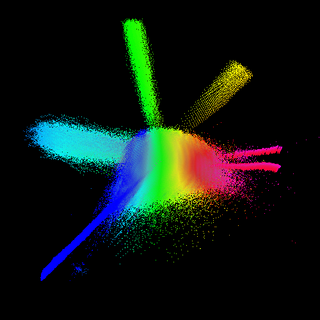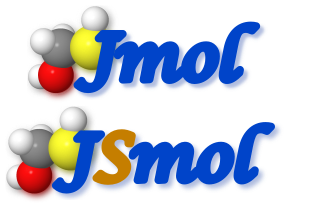
Computer-aided design (CAD) is the use of computers to aid in the creation, modification, analysis, or optimization of a design. This software is used to increase the productivity of the designer, improve the quality of design, improve communications through documentation, and to create a database for manufacturing. Designs made through CAD software help protect products and inventions when used in patent applications. CAD output is often in the form of electronic files for print, machining, or other manufacturing operations. The terms computer-aided drafting (CAD) and computer-aided design and drafting (CADD) are also used.
A chemical database is a database specifically designed to store chemical information. This information is about chemical and crystal structures, spectra, reactions and syntheses, and thermophysical data.
A molecule editor is a computer program for creating and modifying representations of chemical structures.
A chemical file format is a type of data file which is used specifically for depicting molecular data. One of the most widely used is the chemical table file format, which is similar to Structure Data Format (SDF) files. They are text files that represent multiple chemical structure records and associated data fields. The XYZ file format is a simple format that usually gives the number of atoms in the first line, a comment on the second, followed by a number of lines with atomic symbols and cartesian coordinates. The Protein Data Bank Format is commonly used for proteins but is also used for other types of molecules. There are many other types which are detailed below. Various software systems are available to convert from one format to another.

Chemical space is a concept in cheminformatics referring to the property space spanned by all possible molecules and chemical compounds adhering to a given set of construction principles and boundary conditions. It contains millions of compounds which are readily accessible and available to researchers. It is a library used in the method of molecular docking.

Jmol is computer software for molecular modelling chemical structures in 3-dimensions. Jmol returns a 3D representation of a molecule that may be used as a teaching tool, or for research e.g., in chemistry and biochemistry.
Molecular graphics is the discipline and philosophy of studying molecules and their properties through graphical representation. IUPAC limits the definition to representations on a "graphical display device". Ever since Dalton's atoms and Kekulé's benzene, there has been a rich history of hand-drawn atoms and molecules, and these representations have had an important influence on modern molecular graphics.
A molecular model is a physical model of an atomistic system that represents molecules and their processes. They play an important role in understanding chemistry and generating and testing hypotheses. The creation of mathematical models of molecular properties and behavior is referred to as molecular modeling, and their graphical depiction is referred to as molecular graphics.

ISIS/Draw was a chemical structure drawing program developed by MDL Information Systems. It introduced a number of file formats for the storage of chemical information that have become industry standards.
BIOVIA is a software company headquartered in the United States, with representation in Europe and Asia. It provides software for chemical, materials and bioscience research for the pharmaceutical, biotechnology, consumer packaged goods, aerospace, energy and chemical industries.
ChemSpider is a freely accessible online database of chemicals owned by the Royal Society of Chemistry. It contains information on more than 100 million molecules from over 270 data sources, each of them receiving a unique identifier called ChemSpider Identifier.
Chemaxon is a cheminformatics and bioinformatics software development company, headquartered in Budapest with 250 employees. The company also has offices in Cambridge, San Diego, Basel and in Prague. and it has distributors in China, India, Japan, South Korea, Singapore, and Australia.
Inte:Ligand was founded in Maria Enzersdorf, Lower Austria (Niederösterreich) in 2003. They established the company headquarters on Mariahilferstrasse in Vienna, Austria that same year.
LigandScout is computer software that allows creating three-dimensional (3D) pharmacophore models from structural data of macromolecule–ligand complexes, or from training and test sets of organic molecules. It incorporates a complete definition of 3D chemical features that describe the interaction of a bound small organic molecule (ligand) and the surrounding binding site of the macromolecule. These pharmacophores can be overlaid and superimposed using a pattern-matching based alignment algorithm that is solely based on pharmacophoric feature points instead of chemical structure. From such an overlay, shared features can be interpolated to create a so-called shared-feature pharmacophore that shares all common interactions of several binding sites/ligands or extended to create a so-called merged-feature pharmacophore. The software has been successfully used to predict new lead structures in drug design, e.g., predicting biological activity of novel human immunodeficiency virus (HIV) reverse transcriptase inhibitors.
A nuclear magnetic resonance spectra database is an electronic repository of information concerning Nuclear magnetic resonance (NMR) spectra. Such repositories can be downloaded as self-contained data sets or used online. The form in which the data is stored varies, ranging from line lists that can be graphically displayed to raw free induction decay (FID) data. Data is usually annotated in a way that correlates the spectral data with the related molecular structure.
This is a list of notable computer programs that are used for nucleic acids simulations.

Antony John Williams is a British chemist and expert in the fields of both nuclear magnetic resonance (NMR) spectroscopy and cheminformatics at the United States Environmental Protection Agency. He is the founder of the ChemSpider website that was purchased by the Royal Society of Chemistry in May 2009. He is a science blogger and an author.
Chematica is a software that uses algorithms and a collective database to predict synthesis pathways for molecules. The software development, led by Bartosz A. Grzybowski, was publicized in August 2012. In 2017, the software and database were wholly purchased by Merck KGaA | MRK. Since the acquisition, the software has been made commercially available as Synthia.
ChemWindow is a chemical structure drawing molecule editor and publishing program now published by John Wiley & Sons as of 2020, originally developed by Bio-Rad Laboratories, Inc. It was first developed by SoftShell International in the 1990s. Bio-Rad acquired this technology in 1996 and eventually made it part of their KnowItAll software product line, offering a specific ChemWindow edition of their software for structure drawing and publishing. They have also incorporated ChemWindow structure drawing components into their KnowItAll spectroscopy software packages with their DrawIt, ReportIt, and MineIt tools.
Molecular Operating Environment (MOE) is a drug discovery software platform that integrates visualization, modeling and simulations, as well as methodology development, in one package. MOE scientific applications are used by biologists, medicinal chemists and computational chemists in pharmaceutical, biotechnology and academic research. MOE runs on Windows, Linux, Unix, and macOS. Main application areas in MOE include structure-based design, fragment-based design, ligand-based design, pharmacophore discovery, medicinal chemistry applications, biologics applications, structural biology and bioinformatics, protein and antibody modeling, molecular modeling and simulations, virtual screening, cheminformatics & QSAR. The Scientific Vector Language (SVL) is the built-in command, scripting and application development language of MOE.






